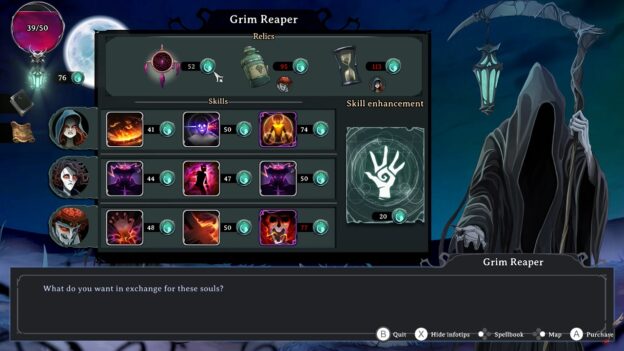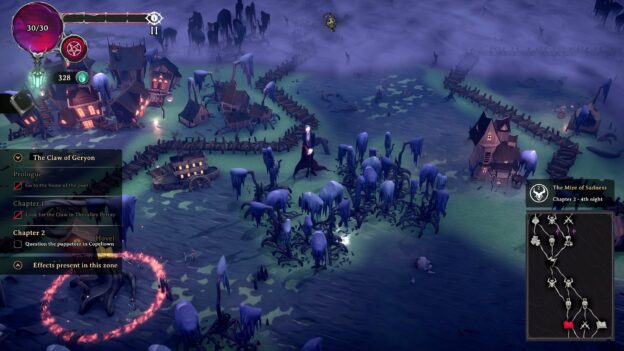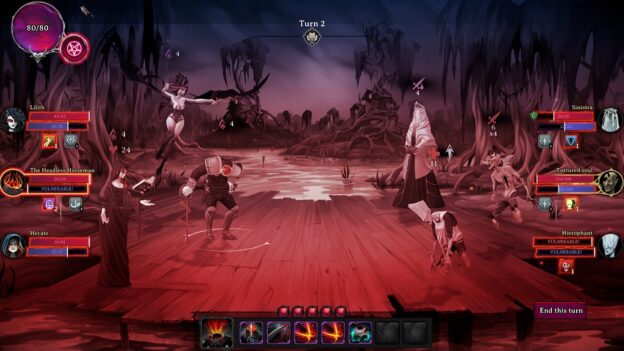People, eh? They’re the worst, right? Man, I sometimes wish that I could just gather up all of my most evil disciples and wreak havoc and strike fear into those nasty mortals… oh, sorry, that wasn’t me. It was the Devil talking… I promise. In Rogue Lords, a dark, fantasy roguelike RPG, you are the Devil!
Rogue Lords sets the scene where mortals and demon hunters have run monsters, villains and demons out of their world. You, the Devil, have decided to make the comeback of all comebacks and not just return alone with a vengeance, but return with a slew of disciples. Disciples include Dracula, Bloody Mary, Dr. Frankensten, The Headless Horseman, Lilith (oh Lilith…), etc. These characters are so well designed and full of life. What’s more, everyone has a voice with key phrases, and many cutscenes and pieces of lore are coupled with some very well done voice acting.
During each stage – called books in Rogue Lords – you choose three disciples. These lucky minions will then head into the world of mortals, encountering battles, taking over towns, and shaping the story’s narrative through various dialogue choices.
 Each book is broken up into chapters. Each chapter represents a single night in each section of the map. Every town you traverse will have at least one objective to complete before moving on to the next. This can include a battle, an encounter with the Grim Reaper (who acts as the shop where you can upgrade stats and buy moves), a cutscene with mortals or other demons where your choices will impact the story and change your disciple’s stats, as well as other stations that can replenish your team, or help you find valuable items.
Each book is broken up into chapters. Each chapter represents a single night in each section of the map. Every town you traverse will have at least one objective to complete before moving on to the next. This can include a battle, an encounter with the Grim Reaper (who acts as the shop where you can upgrade stats and buy moves), a cutscene with mortals or other demons where your choices will impact the story and change your disciple’s stats, as well as other stations that can replenish your team, or help you find valuable items.
The map design in Rogue Lords is pretty basic and linear with branching paths. However, on your map indicator, you can see what lies ahead, which allows you to decide what you want to face in later chapters.
The overworld sprites of your disciples are a little rough around the edges, and nothing compares to their art designs in the menus or in the battles. The sprites are easily the least attractive part of the game, which harms the atmosphere and pacing – having to literally run from one town to another adds no value and, if anything highlights the poor overworld sprites that much more, and makes characters like The Headless Horseman looks comedic as you bunch into tiny bushes and trees because you need to run between them and not through them!
 The main attraction of Rogue Lords is the battle system, or so I thought it would be. Don’t get me wrong, it’s visually impressive, and it works well. Still, there are so many little details to complicate things, and the difficulty seems unfair at times. I understand that this is marketed as tactical battles, but there is only so much you can do with what is offered – and I found that once you find one tactic that works, you just rinse and repeat, which isn’t very fun at all.
The main attraction of Rogue Lords is the battle system, or so I thought it would be. Don’t get me wrong, it’s visually impressive, and it works well. Still, there are so many little details to complicate things, and the difficulty seems unfair at times. I understand that this is marketed as tactical battles, but there is only so much you can do with what is offered – and I found that once you find one tactic that works, you just rinse and repeat, which isn’t very fun at all.
The way in which the battle system works in Rogue Lords is usually a 3 v 3 or less, turn-based system. Your opponents declare their attacks before you decide on yours, so you know what’s coming. This allows you to plan. You can make up to five actions across your three disciples; however, many moves and abilities worth doing cost more than one action. I guess this is where the tactical element comes in. I would often find myself being one action too short on stringing a perfect, game-winning combination – which is frustrating – or I would solely use a disciple such as Bloody Mary, who, when used well, can do it all on her own.
 Even more frustrating is the time it takes to navigate these battle menus. Rogue Lords was initially released on PC, and it shows. Little has been done to accommodate the Nintendo Switch. There are plenty of button presses to select a disciple, an action, and someone to hit, among other options available to you in a battle.
Even more frustrating is the time it takes to navigate these battle menus. Rogue Lords was initially released on PC, and it shows. Little has been done to accommodate the Nintendo Switch. There are plenty of button presses to select a disciple, an action, and someone to hit, among other options available to you in a battle.
After reducing an enemy’s health to zero, they do not faint. Unless they are bleeding, you must use another action point to deal a final blow to them. If you run out of action points, you need to wait until your next turn to deal this last blow, during which time the enemy may buff or heal whoever was vulnerable. Another mechanic that just draws out these battles. As touched on previously, the difficulty of Rogue Lords is pretty great. Even the normal difficulty provides a challenge, and I feel that Leikir Studios and Cyanide knew this, so they implemented the Devil Mode.
Devil Mode is essentially your own cheat code. You can select this mode in battles, when navigating the map, and when in conversation with mortals and other demons. This mode freezes time and allows you to alter things. Want to knock an enemy’s health from full to zero? Do it. Don’t like the path you’re on on the map? Change it. Want a better chance in one of your decisions with a mortal? Just up it. This comes at the cost of essence, which can be replenished at various times and earned relatively quickly throughout Books, so it can be used whenever you’re in need to – or when you’re bored and just want to progress quicker, which is how I often used it. Again, an interesting mechanic, but meshed with everything else; it just feels like they had too many ideas with Rogue Lords and didn’t know which to strip back or refine. It all just feels a little messy in the most tedious way.
 When you aren’t in a book, you’ll find yourself in The Devil’s Lair. This is where you can launch yourself into a book, look at the books you’ve been through, view and learn more about your disciples, and check your progress and stats of previous runs. There isn’t much else in this area; it mainly acts as your main menu before starting a new book.
When you aren’t in a book, you’ll find yourself in The Devil’s Lair. This is where you can launch yourself into a book, look at the books you’ve been through, view and learn more about your disciples, and check your progress and stats of previous runs. There isn’t much else in this area; it mainly acts as your main menu before starting a new book.
The highlight of Rogue Lords is the art design. This is initially what drew me to the game and my reason for wanting to review this. I adore the character designs, and the voice acting adds a lot of charm to Rogue Lords. The battles look clean, the animation put into moves, and the models look great. It is just a shame that the gameplay doesn’t back this up. I also experienced several performance issues. For any move in a battle that had a large-scale animation (hit multiple foes or affect a large portion of the screen – I’m looking at you, Van Helsing), the screen would freeze and then skip a bunch of frames or suddenly play catch up. This massively harmed my experience with Rogue Lords as the visuals were the standout. For potentially the best-looking visuals being the ‘significant actions’, stuttering and failing really spoiled my enjoyment of that aspect.
Review: Rogue Lords (Nintendo Switch)
Average
Rogue Lords is very pretty. They nailed the art design and character models, which I imagine will attract many people to this roguelike RPG. However, I am afraid that the attraction is surface level. With any roguelike game, you expect each run to feel different from the next and reset that excitement and engagement. Still, with Rogue Lords, once you’ve completed three books or so, it doesn’t feel like it has any more to offer. Getting through three books is an achievement, as the gameplay and battle system is tedious, hard and repetitive. With a bit more streamlining of some mechanics and improvements in pacing, you’ll have a more polished title that I’d be more comfortable recommending.


